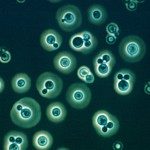Link to Pubmed [PMID] – 31882399
Link to DOI – 10.1534/genetics.119.302740
Genetics 2020 03; 214(3): 635-649
The MAT locus of Cryptococcus neoformans has a bipolar organization characterized by an unusually large structure, spanning over 100 kb. MAT genes have been characterized by functional genetics as being involved in sexual reproduction and virulence. However, classical gene replacement failed to achieve mutants for five MAT genes (RPL22, RPO41, MYO2, PRT1, and RPL39), indicating that they are likely essential. In the present study, targeted gene replacement was performed in a diploid strain for both the α and a alleles of the ribosomal genes RPL22 and RPL39 Mendelian analysis of the progeny confirmed that both RPL22 and RPL39 are essential for viability. Ectopic integration of the RPL22 allele of opposite MAT identity in the heterozygous RPL22a/rpl22αΔ or RPL22α/rpl22aΔ mutant strains failed to complement their essential phenotype. Evidence suggests that this is due to differential expression of the RPL22 genes, and an RNAi-dependent mechanism that contributes to control RPL22a expression. Furthermore, via CRISPR/Cas9 technology, the RPL22 alleles were exchanged in haploid MATα and MATa strains of C. neoformans These RPL22 exchange strains displayed morphological and genetic defects during bilateral mating. These results contribute to elucidating functions of C. neoformans essential mating type genes that may constitute a type of imprinting system to promote inheritance of nuclei of both mating types.

